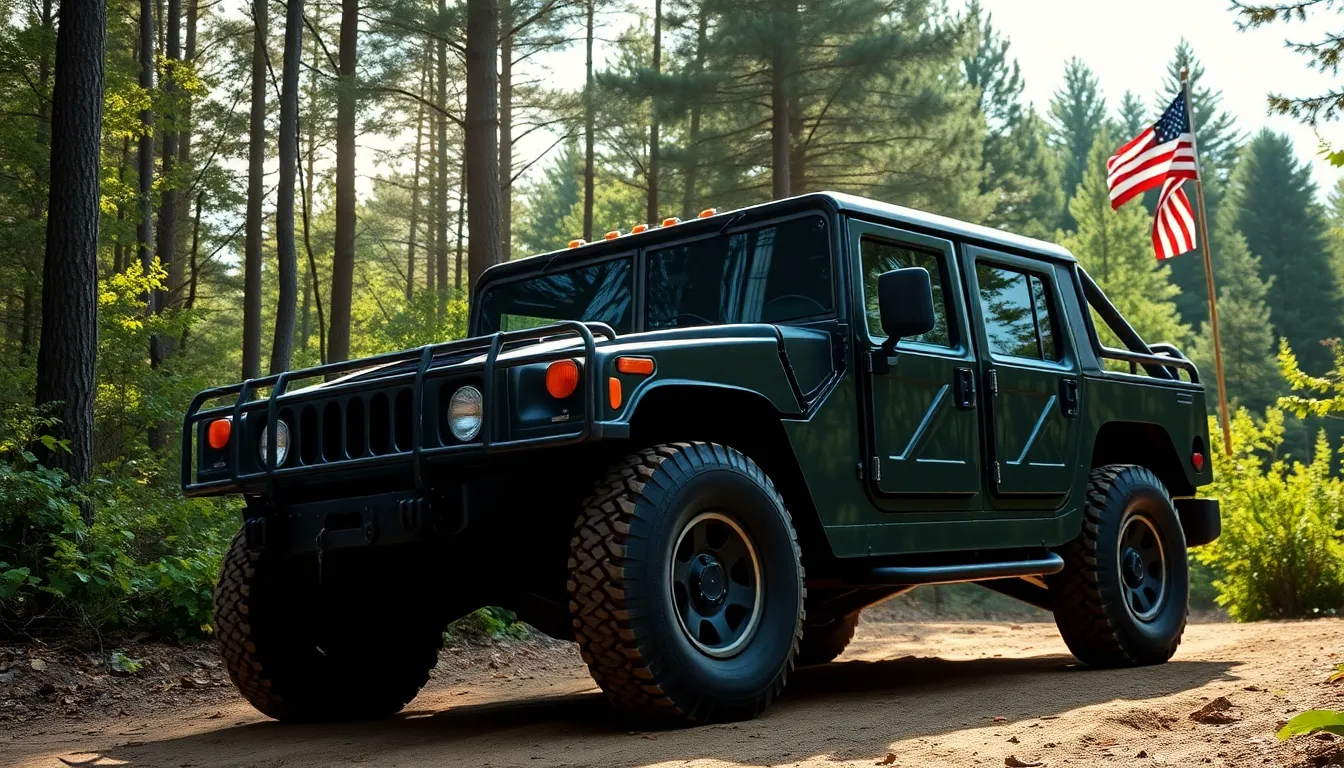When we think of commanding presence on the road, few vehicles match the sheer dominance of Hummer cars. These military-inspired giants transformed from battlefield workhorses into civilian status symbols, capturing America’s fascination with power and prestige. We’ve witnessed how these massive machines became synonymous with luxury, capability, and unapologetic boldness.
The Hummer’s journey from military utility vehicle to mainstream automotive icon tells a fascinating story of American automotive culture. We’ve seen how General Motors successfully marketed these fuel-thirsty beasts to civilians who craved something different from typical SUVs. Their distinctive boxy design and impressive off-road capabilities made them instantly recognizable.
Today’s automotive industry looks vastly different, but Hummer’s legacy continues to influence modern vehicle design and marketing. We’ll explore how these remarkable machines shaped consumer expectations for luxury SUVs and why they remain culturally important even after production ended. Understanding Hummer’s impact helps us appreciate the evolution of American automotive preferences.
The Rise of Hummer Cars: From Military Might to Civilian Streets
We witnessed one of automotive history’s most remarkable transformations when military utility vehicles conquered civilian driveways. The journey from battlefield necessity to suburban status symbol reshaped American car culture forever.
From HMMWV to H1: The Military Origins
HMMWV development began in 1979 when AM General designed the High Mobility Multipurpose Wheeled Vehicle for U.S. military operations. We saw these rugged machines prove their worth across diverse terrains, from desert sand to mountain rock. Military specifications demanded vehicles that could carry 2,500 pounds while maintaining exceptional ground clearance and stability.
Desert Storm exposure in 1991 brought HMMWV vehicles into American living rooms through television coverage. Civilians watched these imposing machines navigate challenging environments with ease. Media attention sparked curiosity about owning similar capabilities for recreational use.
Civilian adaptation created the Hummer H1 in 1992 when AM General modified military designs for consumer markets. Engineers maintained the 6.5-liter diesel engine and four-wheel-drive system while adding comfort features. We observed how luxury appointments like air conditioning and premium audio systems transformed utilitarian designs into desirable consumer products.
Performance specifications included a 180-degree turn radius and ability to climb 60-degree slopes. The H1 measured 185 inches long and 86.5 inches wide, making it larger than most civilian vehicles. Ground clearance reached 16 inches, allowing passage over obstacles that stopped conventional SUVs.
General Motors Acquisition and Brand Development
Strategic acquisition occurred in 1999 when General Motors purchased the Hummer brand from AM General for $60 million. GM executives recognized the brand’s potential to capture luxury SUV market segments seeking distinctive styling and capabilities. We saw how this purchase aligned with GM’s strategy to diversify their portfolio with premium offerings.
H2 launch in 2002 marked GM’s first major Hummer product development. Engineers built the H2 on GMT800 platform architecture, sharing components with Chevrolet Tahoe and GMC Yukon models. This approach reduced manufacturing costs while maintaining Hummer’s distinctive appearance and off-road capabilities.
Market positioning targeted affluent consumers seeking vehicles that projected success and adventure. GM marketing campaigns emphasized Hummer’s military heritage and extreme capability credentials. We noticed how advertisements featured challenging terrain and emphasized the vehicles’ ability to “go anywhere, do anything” philosophy.
Production expansion included the H3 model in 2005, offering a more accessible entry point to Hummer ownership. The H3 used GM’s GMT355 midsize truck platform while preserving signature design elements like vertical grille slats and angular bodywork. Sales peaked at 71,524 units in 2006 before declining market conditions affected the entire brand.
Iconic Hummer H1: The Ultimate Off-Road Beast
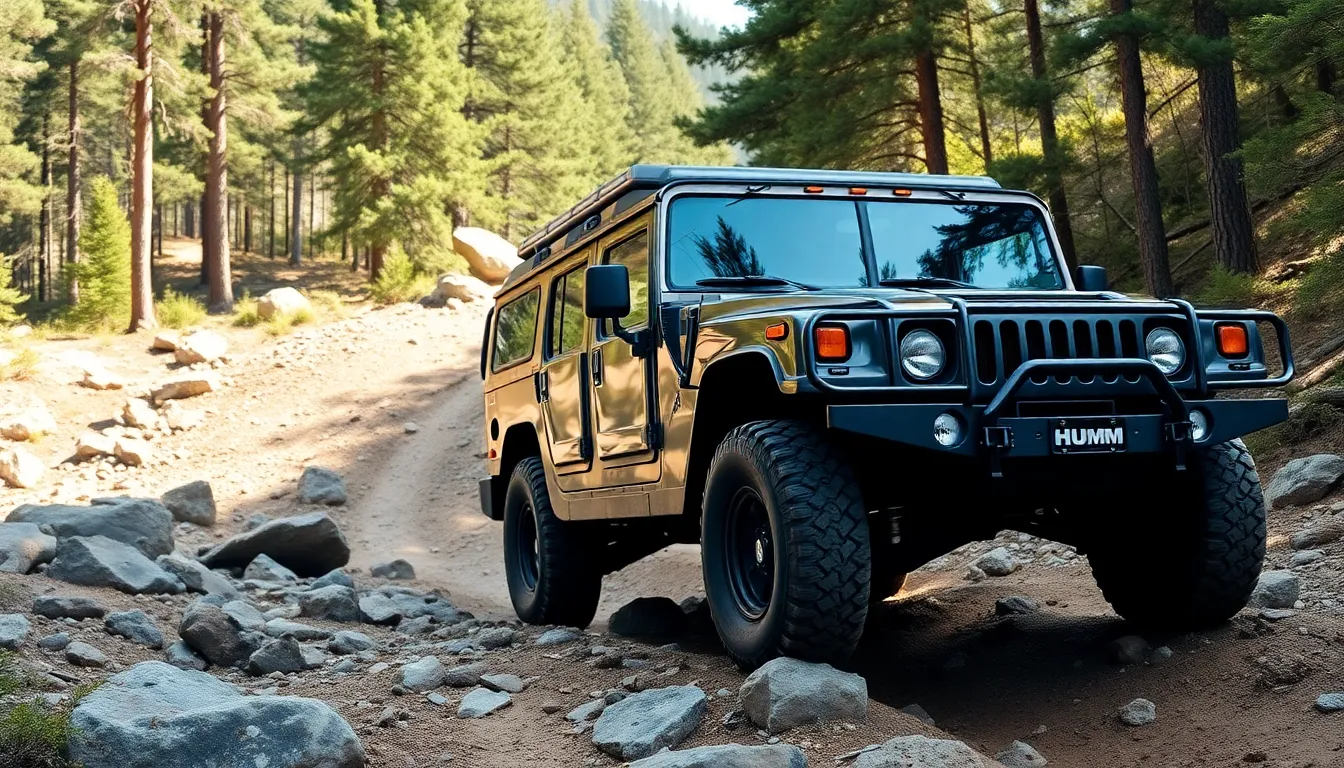
The Hummer H1 represents the pinnacle of civilian off-road capability, directly descended from military battlefield requirements. We’ll explore what made this vehicle a legendary force in extreme terrain navigation.
Unmatched Ground Clearance and Approach Angles
Ground clearance measurements on the H1 reach an impressive 16 inches, allowing drivers to traverse rocks, logs, and deep ruts that would stop conventional SUVs. Approach angles of 72 degrees enable the vehicle to climb steep inclines without scraping the front bumper against obstacles.
Departure angles measure 37.5 degrees, ensuring the rear of the vehicle clears obstacles when descending steep terrain. Breakover angles reach 25.7 degrees, preventing the chassis from getting hung up on ridge lines or large rocks during extreme off-road adventures.
Portal gear hubs raise the differential cases well above potential impact zones, protecting critical drivetrain components from damage. We’ve observed H1 owners confidently handling terrain that would require specialized rock crawling vehicles or ATVs.
Tire clearance accommodates massive 37-inch off-road tires without modification, providing enhanced traction and further increasing ground clearance. Independent suspension at all four corners maintains wheel contact with uneven surfaces, maximizing traction across challenging terrain.
Diesel Engine Performance and Fuel Economy Challenges
Engine options included the 6.2-liter naturally aspirated diesel V8 producing 150 horsepower and 250 lb-ft of torque in early models. Later versions featured the 6.5-liter turbodiesel V8, generating 170 horsepower and 330 lb-ft of torque for improved performance.
Fuel economy averaged between 10-12 miles per gallon in combined driving conditions, making the H1 one of the least fuel-efficient civilian vehicles available. City driving typically yielded 8-10 mpg, while highway cruising could achieve 12-14 mpg under optimal conditions.
Torque delivery characteristics favored low-end power production, essential for rock crawling and steep grade climbing at slow speeds. We’ve noted that the diesel engines provided excellent reliability in extreme conditions but lacked the acceleration performance expected by many civilian drivers.
Transmission options included a 3-speed automatic or 4-speed manual, both designed for durability rather than fuel efficiency or smooth operation. Weight distribution challenges arose from the 8,100-pound curb weight, requiring substantial power to achieve reasonable acceleration times.
Maintenance costs proved significantly higher than conventional SUVs due to specialized components and limited service network availability. Parts availability became increasingly challenging as production ceased, driving up ownership costs for enthusiasts maintaining these vehicles.
Hummer H2: Making Military Style Mainstream
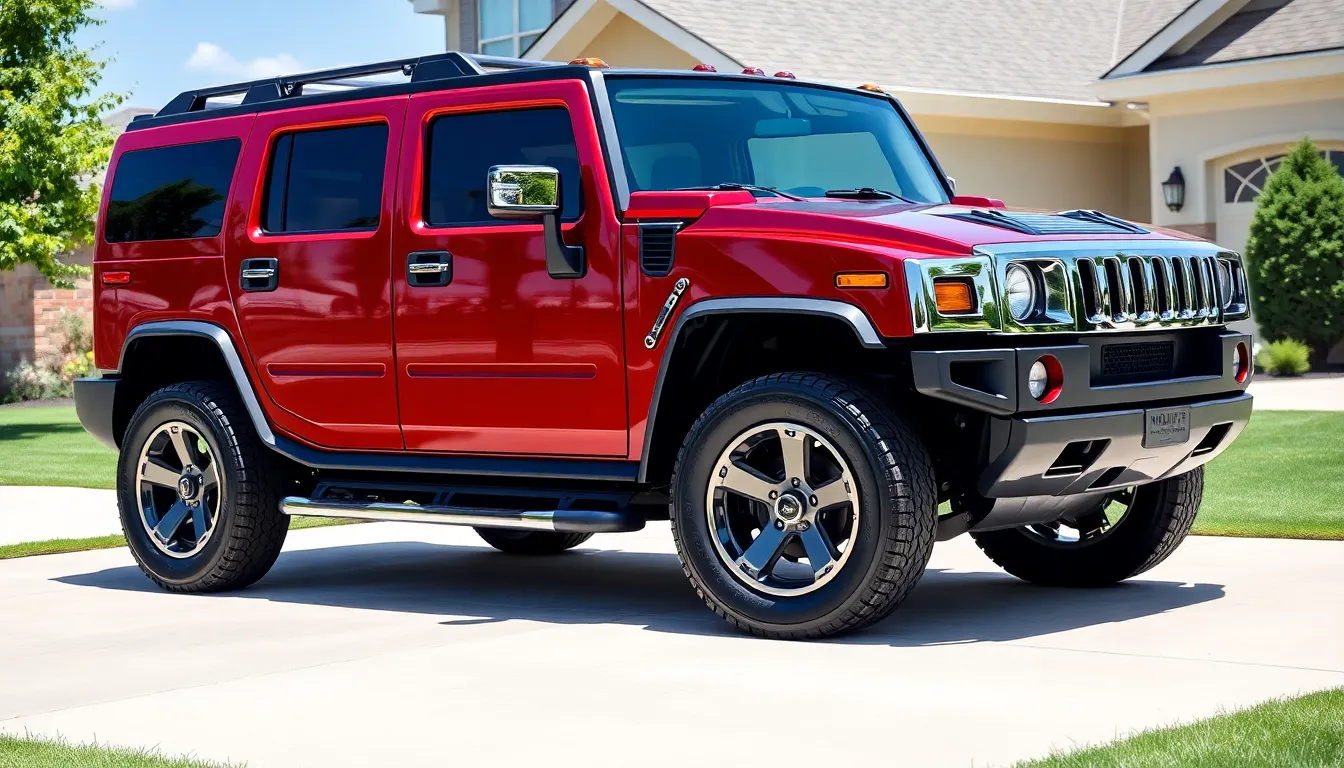
General Motors transformed the Hummer brand’s accessibility with the H2, launching in 2002 to bridge military heritage with everyday usability. This strategic pivot made Hummer’s distinctive presence available to suburban families without the H1’s extreme compromises.
Suburban-Friendly Design Changes
Size reduction made the H2 significantly more manageable than its predecessor, measuring 189.8 inches long compared to the H1’s 184.5 inches while offering better interior space utilization. We see how GM engineers created a more practical footprint that fits standard parking spaces and residential driveways.
Traditional body-on-frame construction replaced the H1’s unique portal axle system, allowing the H2 to use proven Chevrolet Tahoe and Suburban components. This approach reduced manufacturing costs while maintaining the aggressive Hummer aesthetic that buyers demanded.
Lower ride height improved daily driving dynamics and made entry and exit easier for passengers of all ages. The H2 sits closer to conventional SUV proportions while retaining 10 inches of ground clearance for serious off-road capability.
Standard two-wheel drive options became available alongside the traditional four-wheel drive system, appealing to buyers who prioritized fuel economy over maximum off-road performance. This flexibility expanded the H2’s market reach into regions where all-wheel traction isn’t essential.
Interior Luxury Features and Family Appeal
Premium leather seating came standard across H2 trim levels, offering heated front seats and power adjustments that matched luxury SUV expectations. We find these appointments transformed the spartan military interior into a comfortable family environment.
Advanced entertainment systems included OnStar connectivity, premium Bose audio packages, and DVD entertainment systems for rear passengers. These features positioned the H2 as a legitimate family hauler rather than just a weekend adventure vehicle.
Spacious passenger compartments accommodate five adults comfortably with 41.3 inches of front legroom and 36.4 inches of rear legroom. The H2’s interior dimensions rival traditional full-size SUVs while maintaining the distinctive Hummer command seating position.
Cargo capacity reaches 86.6 cubic feet with rear seats folded, providing practical utility for family trips, sporting equipment, and daily hauling needs. This versatility made the H2 appealing to active families who needed both style and substance.
Climate control systems feature dual-zone automatic temperature management, ensuring passenger comfort across all seating positions during long journeys or extreme weather conditions.
Hummer H3: The Compact Alternative That Changed Everything
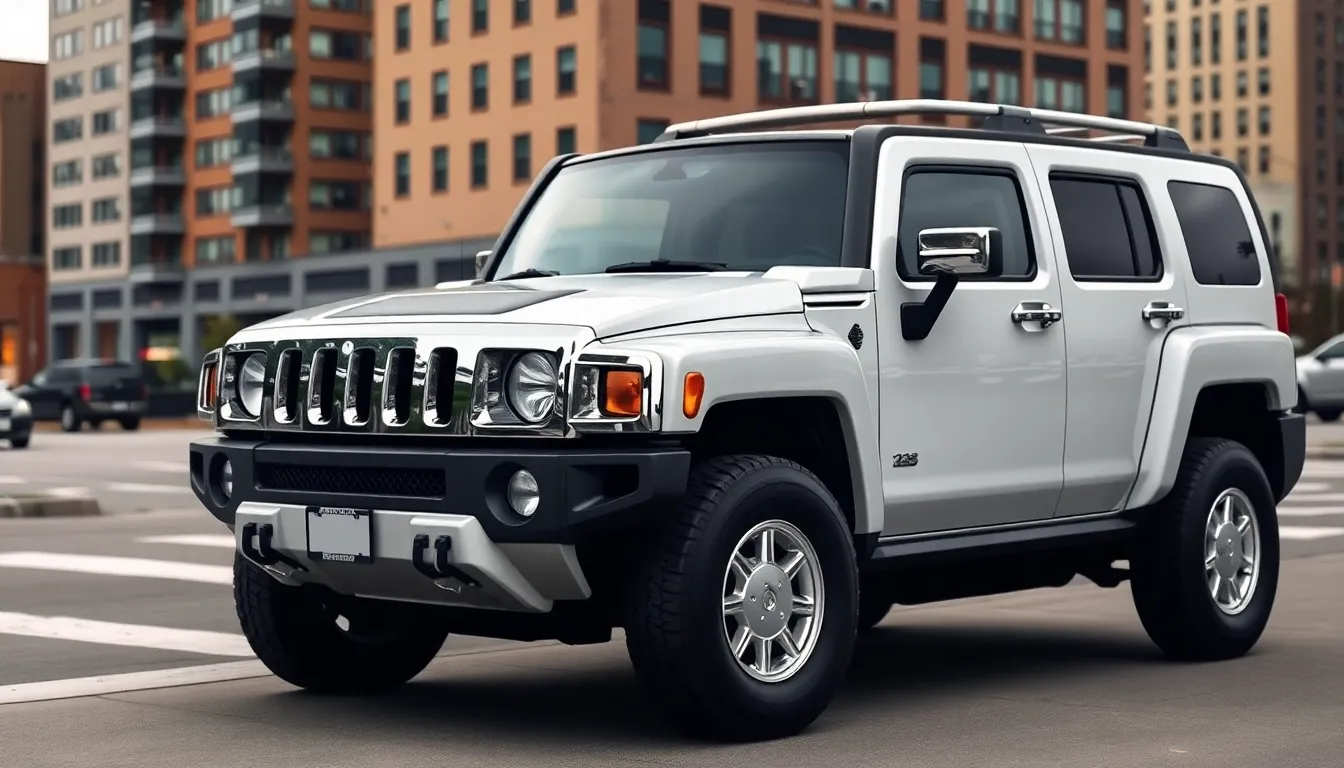
General Motors introduced the Hummer H3 in 2005 as their most radical departure from traditional Hummer design philosophy. This compact SUV represented Hummer’s final attempt to capture mainstream market appeal while maintaining the brand’s rugged identity.
Downsized Dimensions for Urban Driving
Size reduction became the H3’s defining characteristic, measuring 185.6 inches in length compared to the H2’s 203.6 inches. We found this 18-inch reduction made parking in urban environments significantly more manageable. Width decreased from 81.2 inches to 74.7 inches, allowing the H3 to navigate standard city lanes without the intimidation factor of its larger siblings.
Height adjustments dropped from 79.2 inches to 71.9 inches, enabling garage clearance that previously challenged H2 owners. Ground clearance remained impressive at 9.7 inches, preserving off-road capability while accommodating daily commuting needs. Wheelbase shortened to 111.9 inches, improving maneuverability in tight spaces like shopping centers and residential driveways.
Weight distribution totaled approximately 4,600 pounds, making the H3 nearly 2,000 pounds lighter than the H2. This reduction enhanced fuel economy from an average of 10 mpg to a more acceptable 16 mpg combined. Turning radius improved to 37.4 feet, allowing U-turns in standard residential streets where larger Hummers struggled.
Colorado Platform Engineering and Cost Reduction
Platform sharing utilized the Chevrolet Colorado pickup truck architecture, dramatically reducing development costs for General Motors. We discovered this decision allowed Hummer to offer the H3 at $30,595, compared to the H2’s $49,995 starting price. Manufacturing efficiency increased through shared components including suspension systems, drivetrain elements, and interior hardware.
Engine options included a 3.5-liter inline-five producing 220 horsepower and a 3.7-liter inline-five generating 242 horsepower. These powerplants delivered adequate performance while maintaining lower production costs than custom Hummer engines. Four-speed automatic transmission became standard, with a five-speed manual available on base models.
Production streamlining occurred at the Shreveport, Louisiana facility alongside Colorado trucks, reducing overhead expenses significantly. Quality control processes benefited from established Colorado manufacturing procedures, improving initial reliability ratings. Cost savings extended to parts availability, as many H3 components remained interchangeable with Colorado truck parts through dealership networks.
Feature standardization included air conditioning, power windows, and anti-lock brakes as base equipment rather than expensive options. Interior materials shifted from premium leather to durable cloth upholstery, reducing material costs while maintaining functionality. Safety equipment met federal standards without the premium pricing associated with luxury SUV features.
Performance Capabilities That Defined Hummer Cars
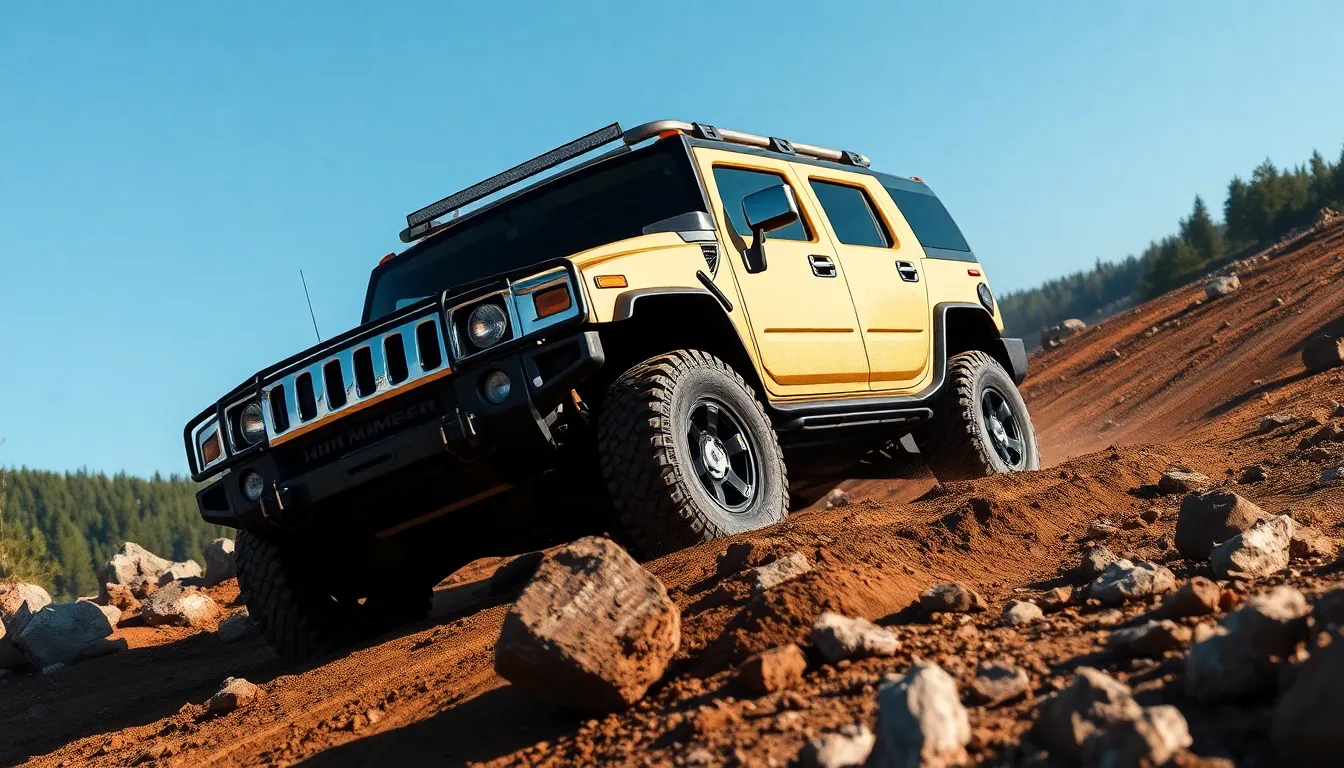
Hummer vehicles earned their legendary reputation through uncompromising performance features that separated them from conventional SUVs. These capabilities transformed military engineering into civilian dominance across the most challenging terrains.
Superior Off-Road Traction and Four-Wheel Drive Systems
Full-time four-wheel drive systems equipped every Hummer model with permanent traction to all four wheels simultaneously. Central tire inflation systems allowed drivers to adjust tire pressure while driving, optimizing grip for sand, snow, mud, and rocky surfaces without stopping the vehicle.
Portal gear hubs positioned the H1’s differential above the wheel centerline, providing exceptional ground clearance of 16 inches while protecting vital drivetrain components. Independent front and rear suspension systems maintained wheel contact with uneven surfaces, ensuring maximum traction during extreme off-road navigation.
Locking differentials distributed power evenly between wheels when traction became compromised on challenging terrain. Electronic traction control systems automatically applied braking force to spinning wheels, redirecting torque to wheels with better grip for continuous forward momentum.
Advanced transfer cases delivered torque distribution ratios optimized for different driving conditions, including highway cruising and extreme off-road climbing. Approach angles of 72 degrees and departure angles of 37 degrees enabled the H1 to navigate steep inclines and descents that would stop other vehicles completely.
Wading Depth and Extreme Weather Performance
Waterproof sealing throughout the drivetrain allowed Hummer vehicles to ford water depths up to 30 inches without engine damage or electrical failure. Breather tubes extended intake and exhaust systems above potential water levels, preventing water intrusion during river crossings and flood conditions.
Cold weather starting systems included engine block heaters and heavy-duty batteries designed for extreme temperature operation down to negative 25 degrees Fahrenheit. Military-grade wiring harnesses resisted moisture, salt corrosion, and temperature extremes that would compromise civilian vehicle electrical systems.
Air intake positioning high above the engine bay prevented water ingestion during deep water crossings, while sealed electrical connections maintained power delivery to critical systems. Underbody skid plates protected vital components from rocks, stumps, and debris during extreme terrain navigation.
Desert cooling systems included oversized radiators and auxiliary cooling fans to prevent overheating during extended low-speed rock crawling in high temperatures. Heavy-duty alternators and charging systems supported winches, auxiliary lighting, and communication equipment during extended off-road expeditions.
The Controversial Side of Hummer Cars Ownership

Even though their impressive capabilities and devoted following, Hummer vehicles sparked important debate throughout their production years. We’ve seen these massive SUVs become lightning rods for criticism about their environmental impact and practical limitations in urban settings.
Environmental Criticism and Fuel Consumption Debates
Environmental activists targeted Hummer owners with intense scrutiny throughout the 2000s, making fuel consumption the primary battleground for criticism. We witnessed the H1 averaging just 10-12 miles per gallon in combined driving conditions, while the H2 managed only slightly better at 10-13 mpg. Even the smaller H3 struggled to exceed 16 mpg in optimal conditions, earning Hummer vehicles a reputation as environmental villains.
Critics organized boycotts against Hummer dealerships, with environmental groups like the Sierra Club launching campaigns specifically targeting these fuel-thirsty vehicles. We observed protesters gathering at auto shows where Hummer displayed their latest models, carrying signs that read “What Would Jesus Drive?” and “Earth Killer.” The backlash intensified during gas price spikes in 2005 and 2008, when some Hummer owners reported receiving angry notes left on their windshields.
Media outlets frequently highlighted the vehicles’ carbon footprint, calculating that a typical H2 produced approximately 11 tons of CO2 annually compared to 5 tons for an average sedan. We saw late-night talk show hosts mock Hummer owners as symbols of American excess, while documentary filmmakers used these vehicles as props to illustrate environmental irresponsibility.
Size Restrictions and Parking Challenges
Urban environments proved particularly hostile to Hummer ownership, creating daily obstacles that many buyers didn’t anticipate. We found that standard parking spaces measured 8.5 feet wide, while the H1 stretched 7.2 feet across and the H2 measured 6.9 feet, leaving minimal maneuvering room. Height restrictions became even more problematic, with the H1’s 6.2-foot height preventing access to most covered parking structures designed for 6-foot clearance.
Downtown parking garages regularly posted “No Hummer” signs, forcing owners to seek street parking or pay premium rates for oversized vehicle spaces. We witnessed many incidents where H2 and H3 owners couldn’t navigate drive-through restaurants, bank ATMs, or car washes designed for conventional vehicles. Multi-story parking structures became off-limits for H1 owners, who often had to park several blocks away from their destinations.
Residential challenges multiplied in urban areas where standard garage doors measured 7 feet wide by 8 feet tall. We documented cases where H1 owners had to modify their garages or park permanently outside, leading to neighborhood disputes and homeowners association complaints. Some municipalities considered regulations specifically targeting oversized personal vehicles, with cities like San Francisco proposing additional registration fees for vehicles exceeding certain weight and size thresholds.
Celebrity Culture and Hummer Cars Status Symbol
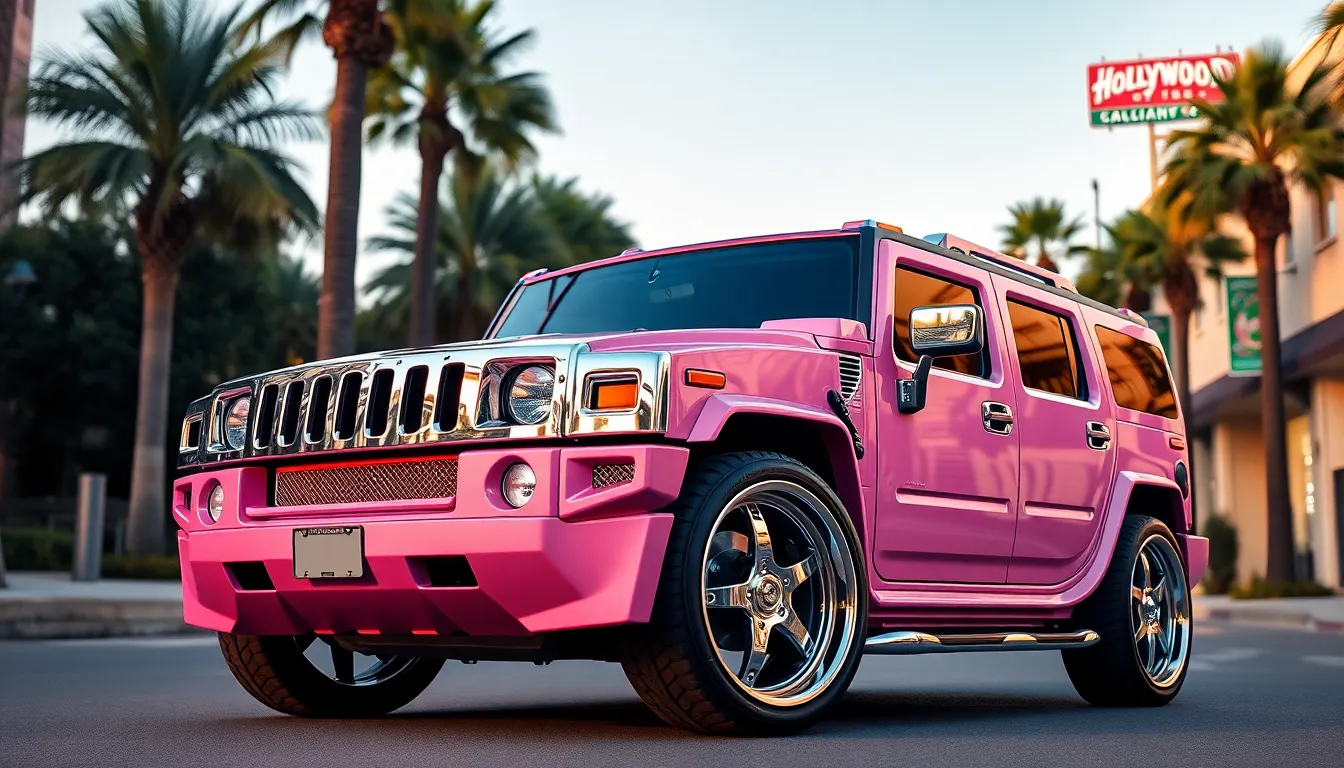
Hummer’s transition from military utility to celebrity luxury transformed these imposing vehicles into powerful status symbols throughout Hollywood and beyond. We’ve witnessed how the brand’s rugged military heritage combined with exclusive pricing created the perfect recipe for A-list appeal.
Hollywood Stars and Their Hummer Collections
Arnold Schwarzenegger led the celebrity Hummer movement, owning multiple H1 models including a hydrogen-powered prototype that showcased his environmental consciousness. His collection became legendary in Hollywood circles, featuring customized military-spec vehicles that reinforced his action hero persona.
Sean Combs (P. Diddy) elevated Hummer ownership to new heights with his fleet of customized H2s, each worth over $200,000 after modifications. Multiple celebrities followed his lead, transforming standard Hummers into rolling works of art with unique paint schemes and luxury interiors.
Britney Spears made headlines with her pink Hummer H2, demonstrating how these vehicles transcended traditional masculine marketing to appeal to female celebrities. Her customization choices influenced a generation of pop stars who saw Hummers as bold fashion statements rather than purely utilitarian vehicles.
LeBron James received a customized Hummer H2 as an 18th birthday gift, sparking controversy about amateur athletics while cementing the vehicle’s status among young celebrities. Athletes across professional sports leagues began acquiring Hummers as symbols of success and financial achievement.
Paris Hilton owned multiple Hummers in signature pink, using them as mobile billboards for her personal brand and demonstrating the vehicle’s potential as a marketing platform. Her influence extended Hummer appeal into reality TV and social media culture, where visibility mattered more than practicality.
Customization Trends and Luxury Modifications
Exterior customization dominated the celebrity Hummer scene, with chrome accessories, custom paint jobs, and oversized wheels becoming standard modifications costing $50,000 or more. Armored plating options provided both status and security for high-profile owners concerned about personal safety.
Interior transformations turned standard Hummer cabins into mobile lounges, featuring leather everything, flat-screen TVs, gaming systems, and premium sound equipment. Celebrity customizers like West Coast Customs built mini nightclubs inside H2s, complete with fog machines and disco lighting.
Performance upgrades included supercharged engines, air suspension systems, and enhanced cooling systems that boosted power while maintaining the vehicle’s imposing presence. These modifications often doubled the purchase price but created truly unique vehicles that commanded attention at red carpet events.
Technology integration became crucial for celebrity Hummers, with custom electronics, satellite communication systems, and mobile office setups transforming vehicles into rolling command centers. Privacy features like tinted windows and communication jammers appealed to celebrities seeking refuge from paparazzi attention.
Signature themes emerged as celebrities collaborated with customizers to create vehicles reflecting their personal brands, from military-inspired designs honoring service members to eco-friendly modifications promoting environmental awareness. Limited edition celebrity Hummers often sold at auction for triple their original purchase prices, cementing their status as collectible investments.
The End of an Era: Hummer Cars Discontinuation
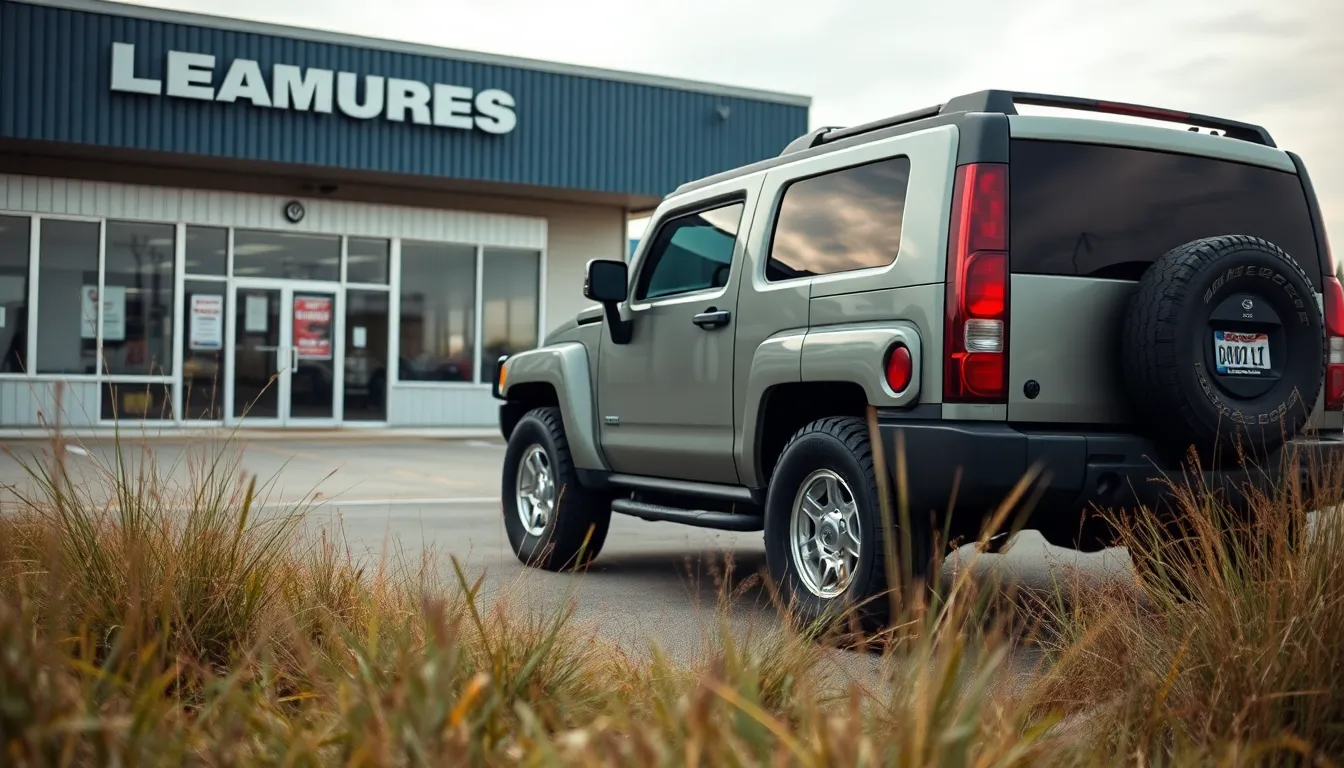
General Motors faced mounting pressure from multiple fronts that eventually sealed the fate of the iconic Hummer brand. We witnessed a perfect storm of economic turmoil and shifting consumer priorities that made these fuel-hungry giants unsustainable in the marketplace.
Economic Recession Impact on Sales
Sales plummeted dramatically during the 2008 financial crisis as American consumers tightened their budgets and reconsidered luxury purchases. We saw Hummer sales drop from 71,524 units in 2006 to just 27,485 units in 2008, representing a devastating 61% decline in just two years. Unemployment rates soared to 10%, forcing potential buyers to prioritize practical transportation over status symbols.
Gasoline prices spiked to over $4 per gallon in 2008, making Hummer ownership financially painful for many families. We observed consumers abandoning gas-guzzling vehicles in favor of fuel-efficient alternatives as economic uncertainty spread nationwide. Credit markets froze, making it nearly impossible for dealers to secure financing for inventory or customers to obtain auto loans.
Luxury vehicle sales across all brands suffered, but Hummer’s extreme fuel consumption made it particularly vulnerable to economic downturn pressures. We noticed that even wealthy consumers began questioning the practicality of owning vehicles that consumed 10-13 miles per gallon during a recession. Dealerships struggled with unsold inventory as customers delayed major purchases indefinitely.
GM’s Brand Restructuring Decision
General Motors filed for bankruptcy protection in June 2009, forcing the company to eliminate non-essential brands to survive financially. We learned that GM’s restructuring plan required cutting four brands, with Hummer joining Pontiac, Saturn, and Saab on the chopping block. Government bailout conditions demanded that GM focus resources on core profitable brands like Chevrolet, Buick, Cadillac, and GMC.
Production costs for Hummer vehicles remained high while sales volume couldn’t justify continued investment in the brand. We discovered that GM spent millions annually maintaining separate dealer networks, marketing campaigns, and manufacturing processes specifically for Hummer models. The company needed to streamline operations quickly to emerge from bankruptcy as a leaner, more profitable organization.
Attempts to sell the Hummer brand to Chinese manufacturer Sichuan Tengzhong Heavy Industrial Machinery fell through in early 2010 due to regulatory complications. We watched as potential buyers struggled to navigate Chinese government restrictions on foreign automotive acquisitions. GM officially announced Hummer’s discontinuation in April 2010 when no viable buyers emerged to continue production.
Environmental pressure groups celebrated the decision as a victory against excessive fuel consumption and carbon emissions. We witnessed the final H3 roll off the production line in May 2010, marking the end of an 18-year civilian production run. The brand that once symbolized American automotive excess became a casualty of economic reality and changing consumer values.
Hummer Cars in Popular Media and Entertainment
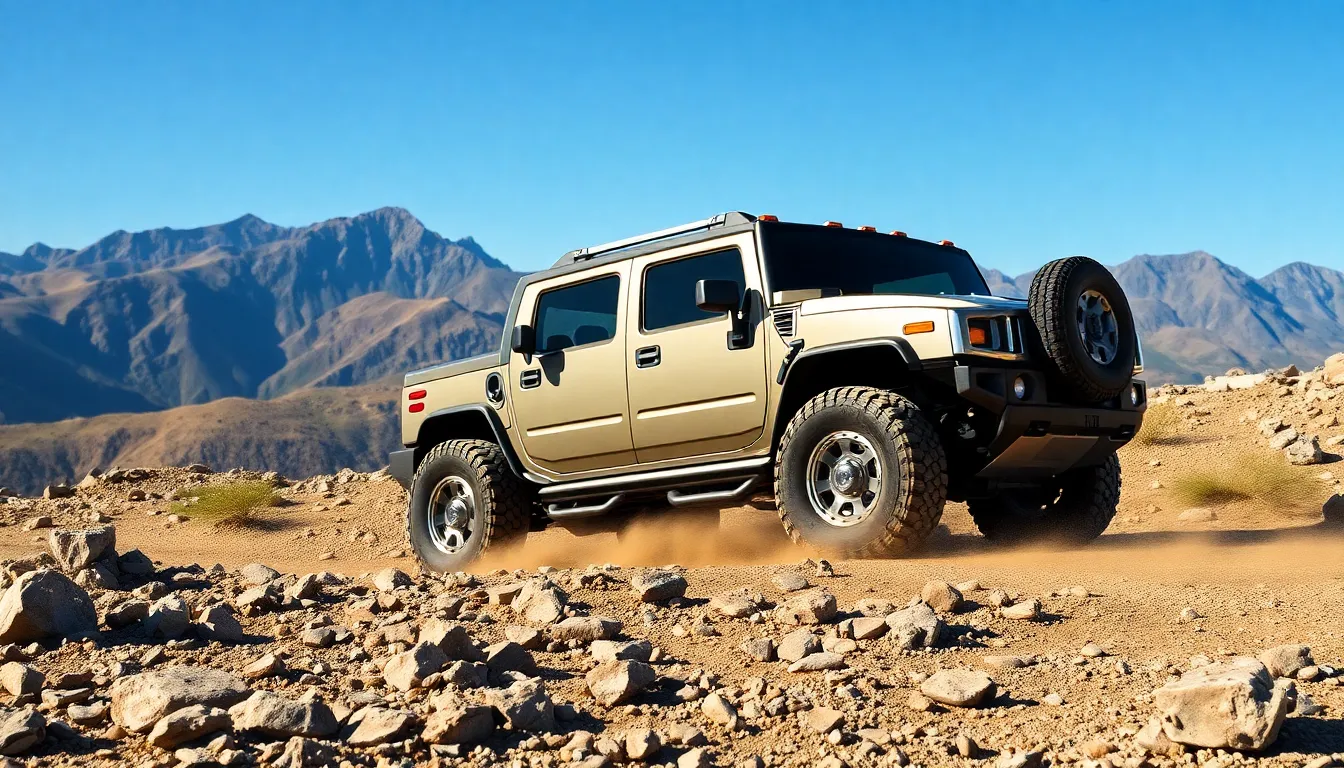
Hummer vehicles transcended their military origins to become cultural icons through extensive appearances in movies, television shows, and digital entertainment. We’ve witnessed these commanding vehicles evolve from functional military hardware to symbols of power and adventure across multiple entertainment platforms.
Movie Appearances and Action Film Stardom
Blockbuster films featured Hummer vehicles as essential elements of high-octane action sequences, establishing their reputation as the ultimate cinematic vehicle for dramatic moments. Arnold Schwarzenegger’s “Terminator 2: Judgment Day” showcased the H1’s impressive capabilities during intense chase scenes, while “Black Hawk Down” authentically portrayed military Humvees in their original combat environment. Action franchises like “The Fast and the Furious” series incorporated customized Hummer models to emphasize raw power and intimidation factor during street racing sequences.
Hollywood productions consistently cast Hummer vehicles as symbols of authority and strength, particularly in military and disaster films where their rugged appearance conveyed instant credibility. Movies such as “Independence Day” featured military Humvees during alien invasion scenarios, while “2012” used civilian Hummer models to navigate apocalyptic terrain. Directors specifically chose these vehicles for scenes requiring authentic military presence or extreme off-road capability demonstrations.
Television series embraced Hummer vehicles for both drama and reality programming, with shows like “24” featuring government agents using H2 models during high-stakes missions. Military documentaries and reality shows frequently highlighted actual Humvee operations in combat zones, providing audiences with authentic glimpses of their battlefield performance. Crime dramas often positioned Hummer vehicles as status symbols for wealthy characters or tools for law enforcement special units.
Video Game Features and Military Simulations
Military simulation games prominently featured Humvee vehicles as core gameplay elements, allowing players to experience authentic combat scenarios from the driver’s seat. Popular titles like “Call of Duty” series integrated detailed Humvee models with realistic handling characteristics, weapon mounting capabilities, and armor protection systems. “America’s Army” provided players with accurate representations of military Humvee variants, complete with tactical communication equipment and convoy operation protocols.
Racing and open industry games incorporated civilian Hummer models as premium vehicle options, emphasizing their unique combination of size, power, and off-road performance. “Grand Theft Auto” series featured Hummer inspired vehicles that players could customize with performance upgrades, luxury modifications, and distinctive paint schemes. Off-road racing simulators like “MotorStorm” showcased Hummer vehicles handling extreme terrain challenges, highlighting their superior ground clearance and four-wheel drive capabilities.
Strategy games utilized Hummer vehicles as essential military units, providing players with versatile transportation and light armored support options. Real-time strategy titles incorporated accurate specifications including fuel consumption rates, passenger capacity, and equipment mounting possibilities. These games educated players about logistical challenges while demonstrating the strategic value of reliable all-terrain transportation in military operations.
Collectible Value and Hummer Cars Market Today

We’re witnessing a remarkable transformation in how collectors and enthusiasts view Hummer vehicles. The brand’s discontinuation has elevated these distinctive SUVs from controversial gas guzzlers to coveted automotive artifacts.
Current Pricing Trends for Vintage Models
H1 models command premium prices ranging from $75,000 to $150,000 for well-maintained examples. These original civilian Hummers attract serious collectors who value their military heritage and uncompromising capabilities.
Pristine H1 Alpha models represent the pinnacle of Hummer collecting, with prices exceeding $200,000 for low-mileage examples. Their Duramax diesel engines and refined interiors make them the most desirable variants among collectors.
H2 vehicles show steady appreciation with clean examples selling between $25,000 and $45,000. Special editions like the H2 SUT pickup variants fetch higher prices due to their unique utility and limited production numbers.
H3 models offer entry-level collecting opportunities at $15,000 to $30,000 for quality examples. Their more manageable size and improved fuel economy appeal to collectors seeking affordable Hummer ownership.
| Model | Price Range | Key Factors |
|---|---|---|
| H1 Standard | $75,000-$150,000 | Military heritage, condition |
| H1 Alpha | $150,000-$200,000+ | Duramax engine, low miles |
| H2 Standard | $25,000-$45,000 | Special editions premium |
| H3 Standard | $15,000-$30,000 | Entry point collecting |
Celebrity-owned Hummers command important premiums, with documented provenance adding thousands to market values. Arnold Schwarzenegger’s custom H1 models regularly exceed standard pricing by 30-50%.
Restoration Projects and Enthusiast Communities
HUMMER communities thrive online through dedicated forums like HummerKnowledge.com and HummerClub.com. These platforms connect owners across continents, sharing technical expertise and restoration guidance.
Restoration specialists emerge nationwide to support growing collector interest. Companies like Predator Inc. and Black Widow offer complete H1 rebuilds, often exceeding original factory specifications.
Parts availability challenges create opportunities for specialized suppliers. Original military surplus components become increasingly valuable as restoration projects demand authentic hardware.
Modified H1 builds represent important investment categories, with custom interiors, modern drivetrains, and luxury amenities. These projects often cost $100,000 to $300,000 beyond the base vehicle price.
Regional Hummer gatherings occur annually across the United States, celebrating the brand’s legacy. Events like the Hummer Owners Group rally in Moab showcase restored vehicles and technical innovations.
Investment potential attracts classic car collectors who recognize Hummer’s unique position in automotive history. Their cultural significance and production cessation create scarcity that drives long-term value appreciation.
Technical preservation efforts focus on documenting original specifications and sourcing replacement parts. Enthusiast groups collaborate with former General Motors engineers to maintain institutional knowledge about these complex vehicles.
Electric Future: Hummer EV and Brand Revival
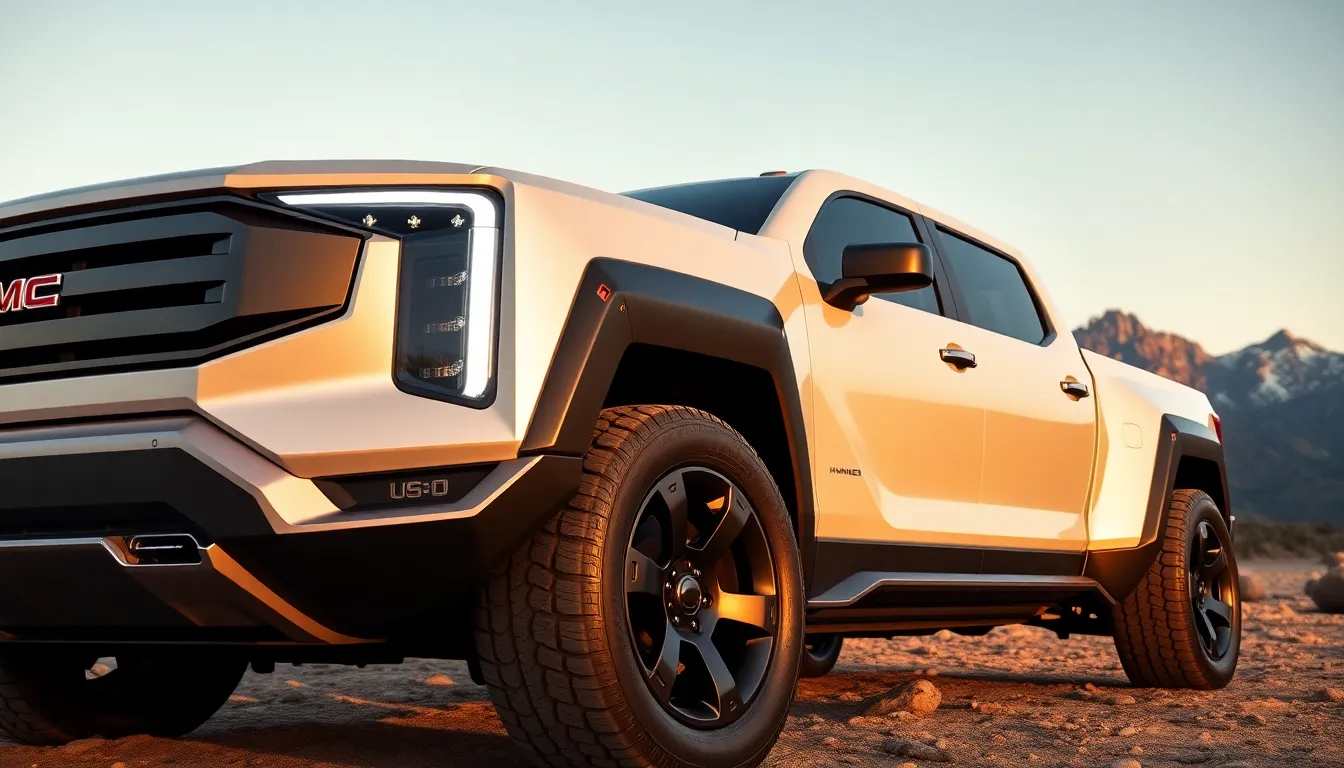
General Motors shocked the automotive industry by reviving the Hummer nameplate as an all-electric vehicle in 2020. We’re witnessing a complete transformation of what Hummer represents in modern transportation.
GMC Hummer EV Launch and Specifications
GMC launched the Hummer EV pickup truck in late 2021, delivering unprecedented electric performance capabilities that redefine the brand’s legacy. We’ve seen this electric powerhouse generate up to 1,000 horsepower and 11,500 lb-ft of torque through its three-motor configuration. The vehicle accelerates from 0-60 mph in just 3.0 seconds, making it one of the quickest pickup trucks ever produced.
Battery capacity reaches 212.7 kWh in the top-tier Edition 1 model, providing an EPA-estimated range of 381 miles on a single charge. We observe that the Hummer EV supports 350 kW DC fast charging, enabling 100 miles of range addition in approximately 10 minutes. The truck’s maximum towing capacity hits 7,500 pounds, while payload capacity reaches 1,300 pounds across different trim levels.
Ground clearance measures 11.9 inches in standard mode and extends to 15.9 inches with air suspension raised to maximum height. We note that approach angles reach 49.7 degrees, departure angles hit 38.4 degrees, and breakover angles achieve 32.2 degrees. Water fording depth extends to 26 inches, maintaining the brand’s reputation for extreme terrain navigation.
Pricing starts at $98,845 for the base EV2 model, while the flagship Edition 1 commands $112,595. We’ve documented that GMC plans to introduce the Hummer EV SUV variant in 2024, expanding the electric lineup’s appeal to traditional SUV buyers.
Technology Integration and Modern Features
Advanced technology systems transform the Hummer EV into a connected powerhouse that far exceeds its predecessor’s capabilities. We experience cutting-edge features through the 13.4-inch infotainment touchscreen running GM’s latest software architecture. The system integrates wireless Android Auto and Apple CarPlay, over-the-air updates, and cloud-based navigation with real-time traffic optimization.
Super Cruise hands-free driving technology comes standard on higher trim levels, enabling autonomous highway driving on over 200,000 miles of compatible roads. We observe that the system uses precision GPS mapping, cameras, and sensors to maintain lane positioning and speed control. Driver monitoring ensures attention remains focused on the road during semi-autonomous operation.
CrabWalk diagonal driving mode represents one of the most innovative features, allowing the vehicle to move diagonally by turning all four wheels in the same direction. We find this capability particularly useful for precise positioning in tight spaces or handling around obstacles. Extract mode raises the suspension to maximum height while captivating rock crawling settings for extreme off-road conditions.
Removable roof panels maintain the open-air driving experience that defined traditional Hummers, while advanced weather sealing prevents water intrusion. We note that the panels store securely in the front trunk, providing convenient access during outdoor adventures. LED lighting systems include signature daytime running lights, adaptive headlights, and customizable interior ambient lighting with multiple color options.
The vehicle features 18 camera views for comprehensive visibility during off-road navigation and parking maneuvers. We appreciate that the UltraVision camera system provides undercarriage views, allowing drivers to see obstacles beneath the vehicle. Bose premium audio delivers concert-quality sound through strategically positioned speakers throughout the cabin.
Conclusion
The Hummer’s remarkable journey from battlefield utility to suburban status symbol and now electric innovation represents one of automotive history’s most fascinating transformations. We’ve witnessed how a military vehicle captured America’s imagination and redefined what luxury SUVs could be.
Though the original Hummer era ended with economic reality, its cultural impact remains undeniable. The brand’s influence on modern SUV design continues today while classic models appreciate as collectible investments.
The electric Hummer EV proves that iconic brands can successfully reinvent themselves for changing times. We’re watching Hummer write its next chapter – one that promises to be just as bold and groundbreaking as its legendary past.
Frequently Asked Questions
What was the original purpose of Hummer vehicles before they became civilian cars?
Hummer vehicles originated from the High Mobility Multipurpose Wheeled Vehicle (HMMWV) designed for military use in 1979. These rugged vehicles were built to withstand extreme conditions and navigate challenging terrains for military operations. The public gained interest in Hummers after seeing them during the Gulf War, which eventually led to civilian adaptations starting with the H1 in 1992.
How fuel-efficient were original Hummer vehicles?
Original Hummer vehicles were notoriously fuel-thirsty. The H1 averaged just 10-12 miles per gallon, while the H2 was slightly better at 10-13 mpg. This poor fuel economy became a major point of criticism, especially during gas price spikes, leading to environmental protests and media ridicule of the brand.
What made Hummer vehicles exceptional for off-road driving?
Hummer vehicles featured full-time four-wheel drive systems, central tire inflation systems, exceptional ground clearance, locking differentials, and electronic traction control. The H1 could ford water, had impressive approach angles, and portal gear hubs that enhanced performance. These military-grade engineering features allowed Hummers to navigate extreme terrains that conventional SUVs couldn’t handle.
Which Hummer model was designed for mainstream consumers?
The Hummer H3, introduced in 2005, was designed for mainstream market appeal. Built on the Chevrolet Colorado platform, it was smaller, more affordable, and easier to drive in urban environments compared to the H1 and H2. The H3 offered better fuel economy and essential amenities without the luxury price tag of its predecessors.
Why did General Motors discontinue the Hummer brand?
The 2008 financial crisis dramatically reduced Hummer sales as consumers prioritized practical transportation over luxury vehicles. GM’s bankruptcy and restructuring forced the company to eliminate non-essential brands. Despite attempts to sell Hummer to a Chinese manufacturer, the deal fell through, leading to the brand’s official discontinuation in April 2010.
Are vintage Hummer vehicles valuable as collectibles today?
Yes, Hummer vehicles have become coveted automotive artifacts since their discontinuation. H1 models command premium prices, while H2 vehicles show steady appreciation. Their cultural significance, scarcity, and unique military heritage make them attractive to collectors and enthusiasts, with many restoration projects and dedicated communities supporting their preservation.
What celebrities were known for owning Hummer vehicles?
Notable celebrity Hummer owners included Arnold Schwarzenegger, Sean Combs, and Britney Spears. These celebrities often customized their Hummers with luxury modifications, extravagant exterior customizations, and interior transformations. Their ownership helped solidify Hummer’s status as a powerful symbol in Hollywood culture and contemporary society.
Is the Hummer brand making a comeback?
Yes, GMC revived the Hummer nameplate as an all-electric vehicle in 2020. The Hummer EV pickup truck launched in late 2021 with up to 1,000 horsepower, 11,500 lb-ft of torque, and 381 miles of range. This represents a complete transformation from fuel-thirsty SUVs to cutting-edge electric vehicles with advanced technology features.
What was the difference between the H1, H2, and H3 models?
The H1 was the most military-like with unmatched off-road capabilities but poor fuel economy. The H2 bridged military heritage with family usability, featuring luxury interiors and better urban manageability. The H3 was the most mainstream-focused, offering improved fuel economy, smaller dimensions, and affordability while maintaining the brand’s rugged identity.
How did Hummer vehicles impact popular culture?
Hummer vehicles became cultural icons through extensive appearances in movies like “Terminator 2” and “Black Hawk Down,” television shows, and video games. They symbolized power, adventure, and authority in entertainment media. This cultural representation helped transform Hummers from military hardware into symbols of American automotive excess and adventure in contemporary culture.

